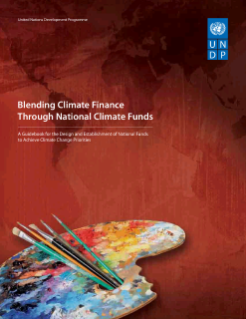Blending Climate Finance through National Climate Funds
-----------------
Climate change is one of today’s most pressing threats to achieving sustainable development goals around the world. Countries must transform their economies and angle their growth with policies and actions across multiple sectors that lower greenhouse gas emissions, reduce vulnerability to climate shocks and cut poverty.
 The good news is that many countries have new and expanded opportunities to finance climate-related actions. Billions from the public and private sectors are to be channeled toward such initiatives.
The good news is that many countries have new and expanded opportunities to finance climate-related actions. Billions from the public and private sectors are to be channeled toward such initiatives.
New funds, such as the Green Climate Fund, will offer new and important resources to support national shifts on reducing the current impact of changing weather patterns and preparing for future scenarios.
More than 50 international public funds, 45 carbon markets and 6,000 private equity funds provide billions of dollars for national-level climate change actions. Between 2009 and 2010, clean energy sector investments worldwide grew 30% to a record US$243 billion.
However, only about one tenth of these investments went outside of countries that are members of the G20 grouping to areas of the world highly vulnerable to shifts in climate patterns, such as the Least Developed Countries (LDCs) and small island developing States (SIDS).
Challenges for developing countries seeking to take climate finance actions include identification of appropriate funding sources, pooling and blending resources, coordinating actions funded by them and developing methods to monitor and evaluate results.
One effective tool – the National Climate Fund (NCF) - puts these countries in the driving seat for managing all aspects of climate finance and making informed choices for directing resources toward results-oriented activities.
NCF design and set-up challenges include building on existing institutions and programmes, and devising governance and project management arrangements that help countries achieve their goals as efficiently as possible.
With experience administering over 750 funds around the world and more than US$5 billion in multi-donor trust funds, the United Nations Development Programme (UNDP) has produced a guide on how countries can lay foundations for driving resources toward national climate and development priorities.
Among the areas covered by Blending Climate Finance Through National Climate Funds are: defining objectives; identifying capitalization; creating effective governance; ensuring sound fiduciary management; supporting efficient implementation; and facilitating effective monitoring, reporting and verification.
Since its launch in September 2011, the guide has already been downloaded hundreds of times and distributed upon request to Jamaica, Lebanon and other countries where I hope it helps in current and future efforts to tap into the increasing volume of climate funding and provide tools to achieve transformational change.
---------------

